Hans Englemann provides a fascinating look, at least what we can see on the surface, at what could be considered somewhat of a musical enigma, given the time, place and volume of output from his hand as opposed to what we can actually find out about him. His is not another ragtime story, but a story of survival in the ragtime era when popular music was starting to make inroads into classical studies and composition. Virtually any pile of large format sheet music from the 1890s to the 1910s is sure to have some H. Engelmann compositions in there. While he was a household name in that regard, particularly among collectors who often encounter his pieces, finding out who he really was is quite a different matter. Here is the best information to date that the author has been able to assemble.
Engelmann was born in Berlin, Germany, in 1872, the son of a top German military officer, Lewis Engelmann and Francisca Walters. Hans' father eventually became a private secretary under Emperor William I. Virtually all male children went through some type of musical training during this period,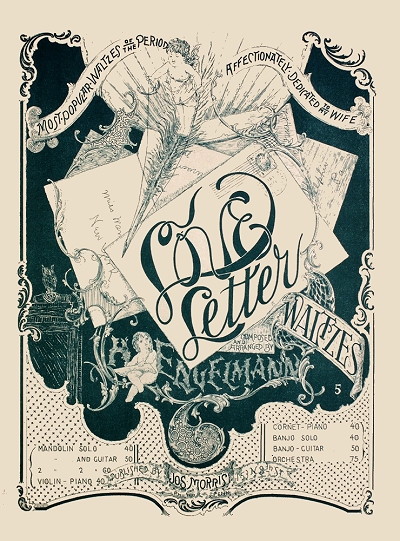 which was the era of Johannes Brahms, and the up and coming Richard Strauss. The main Western European musical forms in Germany at that time were the waltz, march, schottische, polka, and similar genres, some which would become parents of the oft-maligned intermezzo or the reverie. As a result, Englemann likely had little or no exposure to indigenous American forms such as folk melodies or spirituals. He clearly was enamored with music, however, so his father saw to it that he got a proper musical education.
which was the era of Johannes Brahms, and the up and coming Richard Strauss. The main Western European musical forms in Germany at that time were the waltz, march, schottische, polka, and similar genres, some which would become parents of the oft-maligned intermezzo or the reverie. As a result, Englemann likely had little or no exposure to indigenous American forms such as folk melodies or spirituals. He clearly was enamored with music, however, so his father saw to it that he got a proper musical education.
 which was the era of Johannes Brahms, and the up and coming Richard Strauss. The main Western European musical forms in Germany at that time were the waltz, march, schottische, polka, and similar genres, some which would become parents of the oft-maligned intermezzo or the reverie. As a result, Englemann likely had little or no exposure to indigenous American forms such as folk melodies or spirituals. He clearly was enamored with music, however, so his father saw to it that he got a proper musical education.
which was the era of Johannes Brahms, and the up and coming Richard Strauss. The main Western European musical forms in Germany at that time were the waltz, march, schottische, polka, and similar genres, some which would become parents of the oft-maligned intermezzo or the reverie. As a result, Englemann likely had little or no exposure to indigenous American forms such as folk melodies or spirituals. He clearly was enamored with music, however, so his father saw to it that he got a proper musical education.According to an obituary published in the June 1914 issue of Etude Magazine, the original plan for Hans was that music was to be a sideline so that he could enter the medical profession. But the youth had other ideas and rejected that notion. His father placed him in a mercantile office to occupy his time and perhaps sway his son's thinking. It did nothing but strengthen his resolve to be a professional pianist and composer. So it was that Hans immigrated to America on his own in January of 1891, not yet 20, and soon found himself established in Philadelphia, Pennsylvania.
Given the scope of his later output, it may be ascertained that Engelmann continued some of his musical training there with the goal of concertizing first, then perhaps composing and teaching. Among those who supported him was fellow German and Philadelphia composer and choral director Hermann Mohr, who had relocated to the United States just two years prior. The maestro had mentored many other musicians and took Engelmann under his wing in the early 1890s. He may also have taken him in at the Zweckwers Academy of Music. For the next few years Hermann promoted Hans as a brilliant pianist and involved him with many concert appearances in Philadelphia and beyond.
Hans was married to his Pennsylvania-born wife Marie Catharina Gries on August 15, 1894, in Philadelphia. By November 1895 their only daughter, Frances Augusta Maria "Francy", had joined the family. In 1896 Mohr, his mentor and greatest supporter, died, leaving Hans on his own in many respects. Engelmann had already acquired some reputation as a concert pianist, and had also taken on some students. However, it wasn't quite enough for survival in a highly competitive area. So he started submitting compositions for publication. The first published pieces from his hand show up in 1896, including one composition and one arranged piece for Philadelphia publisher M.D. Swisher, and his Marine Band March which established him with the house of Theodore Presser. There are strong indications that the youth had been composing and cataloging his works for some time, since as early as the following year many of them have Opus numbers attached ranging from the 70s to the 200s.
One early work, Love Letters, published in 1897 by Joseph Morris, was "affectionately dedicated to my wife" on the cover. For the next several years, Englemann would free-lance, most likely from his home, sending in classically-structured works to Philadelphia publishers Eclipse Music (specializing in re-arrangements of older works), Hatch Music, Orpheus Music Company and Joseph Morris.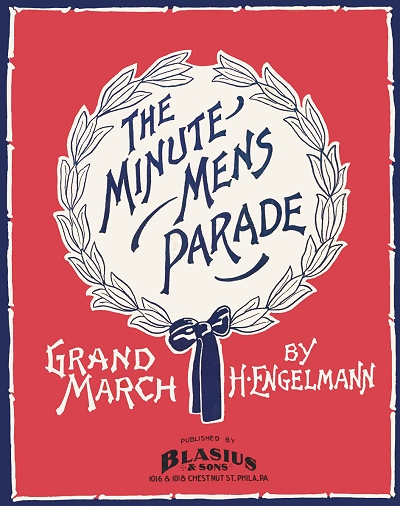 Some of these contributions, particularly those for Eclipse, were reworked piano arrangements of operatic numbers. By the middle of the decade Hans seems to have settled in with the Presser organization as a staff composer and arranger. There are also a couple of advertisements in Philadelphia newspapers and directories indicating that he was working as a piano teacher, which makes sense considering what his future output would be comprised of.
Some of these contributions, particularly those for Eclipse, were reworked piano arrangements of operatic numbers. By the middle of the decade Hans seems to have settled in with the Presser organization as a staff composer and arranger. There are also a couple of advertisements in Philadelphia newspapers and directories indicating that he was working as a piano teacher, which makes sense considering what his future output would be comprised of.
 Some of these contributions, particularly those for Eclipse, were reworked piano arrangements of operatic numbers. By the middle of the decade Hans seems to have settled in with the Presser organization as a staff composer and arranger. There are also a couple of advertisements in Philadelphia newspapers and directories indicating that he was working as a piano teacher, which makes sense considering what his future output would be comprised of.
Some of these contributions, particularly those for Eclipse, were reworked piano arrangements of operatic numbers. By the middle of the decade Hans seems to have settled in with the Presser organization as a staff composer and arranger. There are also a couple of advertisements in Philadelphia newspapers and directories indicating that he was working as a piano teacher, which makes sense considering what his future output would be comprised of.Engelmann had already gained some notoriety in the performance and composing worlds by the early 1900s. In a February 1, 1902, pseudo-advertisement in The Music Trade Review, he was quoted as speaking highly of the Steck brand of piano:
The following voluntary testimonial from H. Engelmann, a bright young composer, whose compositions have become quite popular, is one of many letters which are being received from time to time by Geo. Steck & Co., and their representatives in all sections of the country, expressing the same sentiments regarding the 'old reliable' Steck. It speaks for itself: Engelmann's Studio of Music, Philadelphia, Pa. Gentlemen: - I desire to express my appreciation of the Geo. Steck & Co. pianos. The piano I purchased from you last year, 'Elite' grand, I find to be more than satisfactory. The Steck piano has been a familiar instrument to me for years, and this is one reason for selecting it. In my professional work I have seen almost every piano of note, home and abroad, and I am conscientious in saying that I consider the pianos manufactured by Geo. Steck & Co. the best in tone, action and general workmanship. Yours as ever, H. Englemann.
That Hans was quoted this liberally in a trade magazine gives credence to his stature as a composer in a time when those writing piano rags were still sometimes looked upon with a wary eye.
While a look at his list of his known compositions seem to make Engelmann out as a veritable composing machine, in reality less than half of that output was intended for anything other than the parlor, and rarely the concert hall. Most of the rest is comprised of a number of first through third grade teaching aids. A study of many of these works indicates that the German-trained musician in his guise as a teacher was not only trying to present a wide scope of dance forms to young students, but make them sound like their more difficult counterparts, encouraging the youngsters to grow in their desire to improve.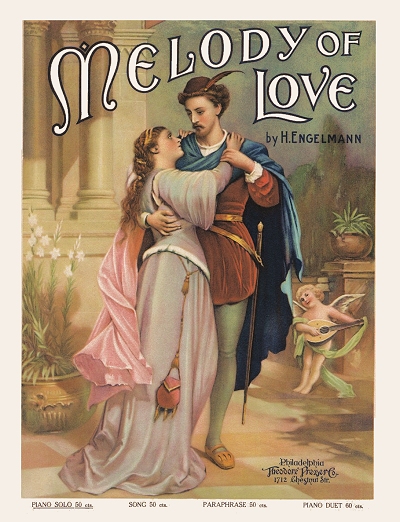 There are several suites that demonstrate dance or classical themes, and some could be played as a sonata of sorts as well. Yet he also sometimes made incursions into the fringes of the popular music market, somewhat in the manner of the prolific if average Carrie Jacobs Bond, who did not write popular music per se, but music that enjoyed some popularity. Engelmann's best-known tune in this regard was Melody of Love in 1903, which did not take long to find a wide overseas market as well as an acceptable one in the United States.
There are several suites that demonstrate dance or classical themes, and some could be played as a sonata of sorts as well. Yet he also sometimes made incursions into the fringes of the popular music market, somewhat in the manner of the prolific if average Carrie Jacobs Bond, who did not write popular music per se, but music that enjoyed some popularity. Engelmann's best-known tune in this regard was Melody of Love in 1903, which did not take long to find a wide overseas market as well as an acceptable one in the United States.
 There are several suites that demonstrate dance or classical themes, and some could be played as a sonata of sorts as well. Yet he also sometimes made incursions into the fringes of the popular music market, somewhat in the manner of the prolific if average Carrie Jacobs Bond, who did not write popular music per se, but music that enjoyed some popularity. Engelmann's best-known tune in this regard was Melody of Love in 1903, which did not take long to find a wide overseas market as well as an acceptable one in the United States.
There are several suites that demonstrate dance or classical themes, and some could be played as a sonata of sorts as well. Yet he also sometimes made incursions into the fringes of the popular music market, somewhat in the manner of the prolific if average Carrie Jacobs Bond, who did not write popular music per se, but music that enjoyed some popularity. Engelmann's best-known tune in this regard was Melody of Love in 1903, which did not take long to find a wide overseas market as well as an acceptable one in the United States.Engelmann was not loyal to any one publisher, as the variety of his pieces fit different needs from teaching to parlor melodies. While many of his early works originated in Philadelphia, he eventually had a considerable presence in the catalogs of M. Witmark and Sons in New York and The Oliver Ditson Company in Boston. He was also published by Shattinger Music in St. Louis, and many of his works went to Carl Fischer Music. One popular Philadelphia publication was the 1906 piece The Philadelphia Record March, of which arrangements were created for bands and piano rolls in short order. It remains a favorite band march into the 21st Century.
While it appears that Hans never actually recorded, a handful of his pieces did make it to piano rolls. To complicate matters concerning an accounting of all of his works, but also demonstrating that he was following a common dispersal practice, the amazingly prolific composer also wrote under the pseudonyms Heinrich Engel, Charles Lindsay and Pierre Renard, further increasing the scope of his known output.
For the 1910 Federal census, Engelmann, Marie and Frances were shown living near downtown Philadelphia, and he listed in a crowded space the occupations of musician, composer and piano teacher. In February 1914, just weeks before his premature demise, Hans Engelmann became a charter member of ASCAP at the Hotel Claridge in New York City.
For the 1910 Federal census, Engelmann, Marie and Frances were shown living near downtown Philadelphia, and he listed in a crowded space the occupations of musician, composer and piano teacher. In February 1914, just weeks before his premature demise, Hans Engelmann became a charter member of ASCAP at the Hotel Claridge in New York City.
Hans Engelmann died in 1914 at just 42 of chronic nephritis (a.k.a. Bright's Disease), exacerbated by liver cirhosis. A notice appeared in The Music Trade Review of May 16, 1914, stating that "Hans Engelmann, composer of much meritorious music which has won a large vogue with teachers, died late last week in Philadelphia." The most effusive praise for Engelmann came from a very logical source, Etude Magazine, a monthly periodical published by Presser that was largely about keeping classic forms of music alive. While in the past they had only reported on his latest compositions or who was playing what in recitals, in June, then in August, there were several tributes to the prematurely deceased composer, starting with this one in the June 1914 issue:
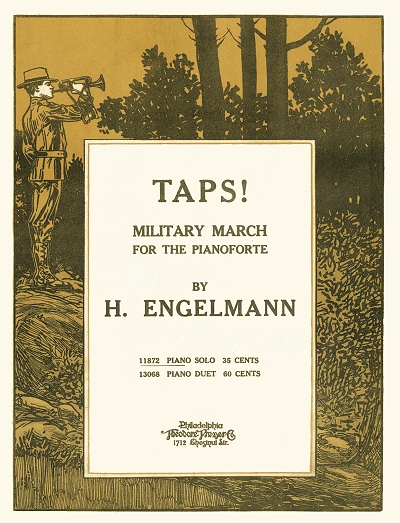
Composers, like poets, are born and not made. It is possible, of course, for a man to go through an elaborate course of harmony, counterpoint, musical form, etc., and at the end of the course to be able to write music that is "well-constructed" and blameless from a theoretical point of view. There are thousands of Doctors of Music in the world to whom the writing of such music is a simple matter. But natural musicians are more rare. Natural musicians are those to whom music is as the breath of life. They think in tones as others think in words and can only find the true expression of their inmost thoughts in the language of music. A course in theory can only develop such gifts to a higher degree of technical perfection, it cannot supply them if they are missing.
Hans Engelmann was unquestionably a natural musician. From him melodies gushed like water from a spring. Engelmann's music possesses at least one quality which no critic can afford to decry. It possesses the quality of absolute sincerity. Engelmann entered into the life of the people around him and absorbed the life of the everyday world. This he gave out again in his music in good measure. He did what so many of us fail to do—the best he knew how under the circumstances in which he was placed. He interpreted the life he lived honestly into music, and in doing this he gave pleasure to hundreds of thousands—perhaps millions—of people, because he gave them tunes they could understand. Hans Engelmann is dead, and dead before his time, but some at least of his hundreds of melodies will live after him and serve to awaken in many a small heart the love of music which unites all Etude readers, however varied their tastes, in the bonds of true fellowship.
He was obviously quite highly regarded for his work, as a number of testimonials poured in to The Etude over the summer, some of them making it into the August issue (distilled for relevance here):
There never has been in America such a prolific and melodious composer as the late Hans Engelmann. some years past, when our native writers began to show what they could do, the first item they seemed studiously to avoid was melody. To speak from my personal experience I attended all the yearly meetings of the National and State Music Teachers' Associations to hear the works of American composers performed, the impression was that all the old forms should be thrown over board, and that no such commonplace as tune and rhythm should be employed. Those of us who have watched the outcome of the effort well know when it ended. Some composers have at once reached the hearts of the people by the simplicity of their melodies, others by the constant performance of them and the popularity of certain artists. In the last finality what one needs to express his deepest feelings is not technique, or scientific contrapuntal examples and exercises, written by learned doctors or professors of music, but real inspirational melody; no matter who wrote it, whether it be a Schubert, Schumann or Engelmann. I have used and played many of Hans Engelmann's writings. About two years ago I purchased several of them for a large publishing house, and one of the numbers being too difficult, we asked him for an easier arrangement, or something of a different style. It was only a few days until we received quite a bundle of new pieces and were requested to take our choice. The musical world has been uplifted and made to feel more keenly the tender and sympathetic qualities of the art in the works of Hans Engelmann. Time and use will put the stamp of approval on those writings of his which are to last, but among them will be "Melody of Love", and "When the Lights are Low". -- W. D. [composer William Dawson] Armstrong
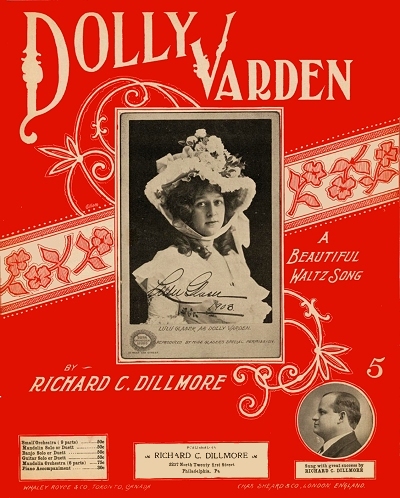
In my estimation Hans Engelmann was one of the great, modern melodists, one of the few composers who never had to seek for a theme, for his supply of that rare product was inexhaustible, his gift in this respect was almost ethereal. None but a Child of Inspiration could have penned such melodies as he has left to the music-loving word. Truly a magnificent monument. I am proud to have known him both as a friend and a musician, and deeply regret his early demise. I predict that posterity will be familiar with the name of Hans Engelmann. -- [popular composer] George L. Spaulding
I was very much grieved to learn of the death of Hans Engelmann. We will miss him and the hopes of anticipating his new compositions. We have scores of his beautiful melodies left us, and we should all dig into his extensive writings and find numerous gems that the public know little of. We all know him for his Melody of Love, little thinking that he has written dozens of "Melodies of Love". Let us do him honor and investigate his writings, as they are the living part of this beloved countryman. -- [popular composer] Thurlow Lieruance
When I first met Hans Engelmann in 1897 I was interested in his work as a composer on account of the fluency of his writing, and the fact that in nearly every one of his pieces he had at least one touch of individuality. At that time he rather prided himself in having reached a high opus number, somewhere between two and three hundred. I remember that on one occasion he remarked that he would like to reach Opus 1000. I do now know what would be the number for his last writing, but I imagine it would be nearer the two thousand mark.
Once the question of his studying compositions with a celebrated teacher came up in the course of a conversation. He gave it as his opinion that were he to put himself to a systematic course of study in the higher forms of composition he would undoubtedly take away from his fertility of invention and weaken his harmonic fancy. If I were to try to characterize his work as a composer, it would be to lay emphasis in his facile melody, animated rhythms and harmonic color, achieving fine effects with resources familiar to the average teacher and pupil. Therein was his strength -- [Editor of The Musician] W.J. Baltzell
Careful arranging, and grading the compositions of Hans Engelmann according to their difficulty of execution, their ever tuneful originality reminds me of the beautiful musical allegory of the Tiny Little Rill; "Trickling from the tip top of the tall mountain, it goes on its mission of mercy; joins in the merry song of the rivulet; dancing a duet over moss covered rocks; playing hide and seek among pretty white pebbles, till they reach the evergreen plain below; there a trio is sung with the voice of the brooklet, as it murmurs through the meadows where the wild flowers grow; thirsty cattle politely bow their heads in gratitude for the cool, freshing drink furnished them by the babbling brook, as it hurries on to the river and thence into the might choral ocean. The genial rays of the tropic sun kiss the waters up into fleecy clouds, which the south wind waft back up to the old mountain peak where they fall in gentle tear drops of rain, singing their song of Sweet Home Again."
True lovers of music, and lovers of true music will gratefully keep the memory of Hans Engelmann ever green. -- [composer] Frank L Bristow
Following his death, it is possible that either Marie submitted his remaining manuscripts to one or more publishers, or those such as Witmark, who had put out much of his material,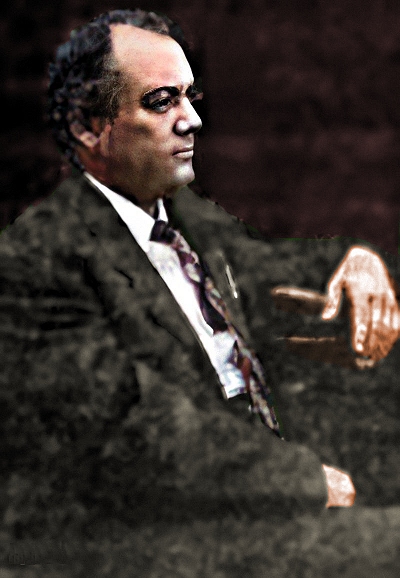 had a backlog of works to issue. Either way, previously unreleased H. Engelmann compositions came out somewhat regularly at first, then sporadically over the next several years. Marie's name also appeared on a veritable flood of copyright renewals in the 1930s and 1940s, which showed her living in Burnholme, Pennsylvania for most of those two decades.
had a backlog of works to issue. Either way, previously unreleased H. Engelmann compositions came out somewhat regularly at first, then sporadically over the next several years. Marie's name also appeared on a veritable flood of copyright renewals in the 1930s and 1940s, which showed her living in Burnholme, Pennsylvania for most of those two decades.
 had a backlog of works to issue. Either way, previously unreleased H. Engelmann compositions came out somewhat regularly at first, then sporadically over the next several years. Marie's name also appeared on a veritable flood of copyright renewals in the 1930s and 1940s, which showed her living in Burnholme, Pennsylvania for most of those two decades.
had a backlog of works to issue. Either way, previously unreleased H. Engelmann compositions came out somewhat regularly at first, then sporadically over the next several years. Marie's name also appeared on a veritable flood of copyright renewals in the 1930s and 1940s, which showed her living in Burnholme, Pennsylvania for most of those two decades.Melody of Love stayed in continuous print for many years, and was a staple of piano roll companies through the 1920s. Around 1942 this piece was fitted with new lyrics and became a mild perennial favorite as Whisper That You Love Me. Another set of lyrics were added to it by Tom Glazer as Melody of Love in 1954 to create what became a Number One Billboard Magazine hit the following year. It was recorded at the very least by The Four Aces, The McGuire Sisters, Frank Sinatra, Tony Martin, and Billy Vaughn whose version put it on the top playlists in the United States, making this his longest surviving work.
Marie was shown as a widow living with her married daughter in the 1920 census, still in Philadelphia. She remained in their household into the 1950s. As Herr Engelmann appears to have been a corporate composer of sorts, that paradigm and a look at various copyrights indicates that he likely did not own much, if any of his music, leaving only his current estate behind and little future revenue. Marie's reacquisition and renewal of many of his copyrights helped to rectify some of that, but Presser also renewed their own copyrights on his works.
What is interesting in this instance is that Englemann demonstrates something often overlooked in the ragtime era - somewhat of a dearth of ragtime compositions from the Philadelphia area. When Harry J. Lincoln moved there several years later, he brought some ragtime with him, but much of his output was like Engelmann's in many ways. The closest Hans came to ragtime in a highly competitive music market was the occasional schottische or polka. While many other European immigrants like J. Bodewalt Lampe and John Stepan Zamecnik adapted their training to either arrange or compose American popular music forms, Engelmann seems to have held out to the very end, resisting ragtime and holding true to the fading forms of waltzes, reveries, caprices, and other time-worn genres. Virtually the last piece he wrote, released shortly after his death, was called Taps!, a march, not the familiar evening bugle call. His name will be forever embedded in numerous important music collections around the world, and what little is known of him personally will likely be best revealed through studied performances of that music.
The initial epic-sized song list for this article was greatly enhanced by at least 20% through the efforts of historian Sue Attalla. The author hopes this biography answers the many queries that prompted it, such as "Who was this guy?" etc. A little of the background information came from the Etude Magazine of June 1914, but the vast majority was obtained from sheet music and publisher records, public records in the United States and Germany, and various periodicals from the time in which Engelmann lived and thrived.
 Compositions
Compositions